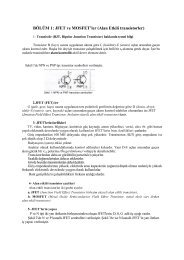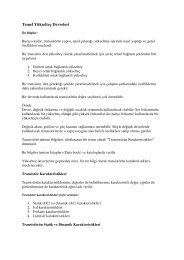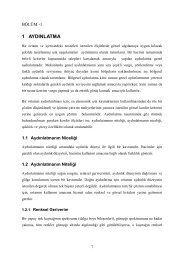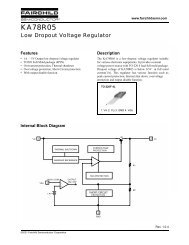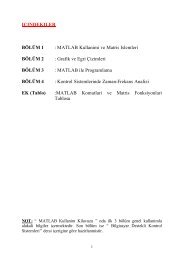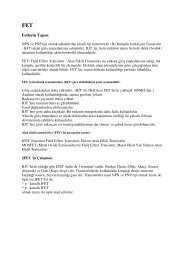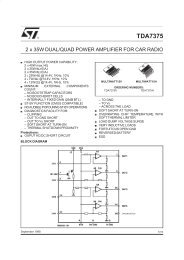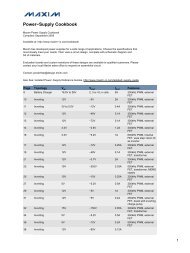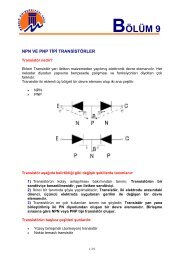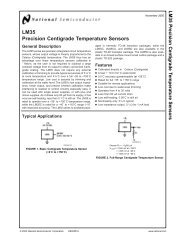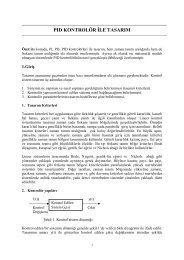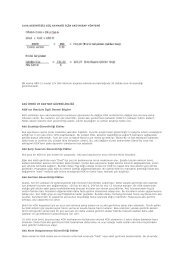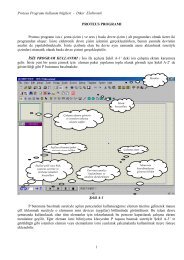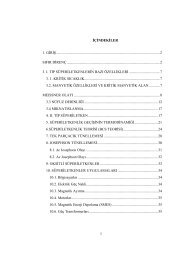Datasheet SHT1x (SHT10, SHT11, SHT15) - 320Volt
Datasheet SHT1x (SHT10, SHT11, SHT15) - 320Volt
Datasheet SHT1x (SHT10, SHT11, SHT15) - 320Volt
You also want an ePaper? Increase the reach of your titles
YUMPU automatically turns print PDFs into web optimized ePapers that Google loves.
<strong>Datasheet</strong> <strong>SHT1x</strong>Sensor PerformanceRelative Humidity 123Parameter Condition min typ max Units0.4 0.05 0.05 %RHResolution 18 12 12 bitAccuracy 2 typical 4.5 %RH<strong>SHT10</strong> maximal see Figure 2Accuracy 2 typical 3.0 %RH<strong>SHT11</strong> maximal see Figure 2Accuracy 2 typical 2.0 %RH<strong>SHT15</strong> maximal see Figure 2Repeatability 0.1 %RHHysteresis 1 %RHNon-linearity linearized
Users Guide <strong>SHT1x</strong>1 Application Information1.1 Operating ConditionsSensor works stable within recommended normal range –see Figure 4. Long term exposures to conditions outsidenormal range, especially at humidity >80%RH, maytemporarily offset the RH signal (+3 %RH after 60h). Afterreturn to normal range it will slowly return towardscalibration state by itself. See Section 1.4 “ReconditioningProcedure” to accelerate eliminating the offset. Prolongedexposure to extreme conditions may accelerate ageing.Relative Humidity (%)100806040200Max. RangeNormalRange-40 -20 0 20 40 60 80 100 120Temperature (°C)Figure 4: Operating Conditions1.2 Soldering instructionsFor soldering <strong>SHT1x</strong> standard reflow soldering ovens maybe used. The sensor is qualified to withstand solderingprofile according to IPC/JEDEC J-STD-020D with peaktemperatures at 260°C during up to 40sec including Pbfreeassembly in IR/Convection reflow ovens.IMPORTANT: After soldering the devices should be storedat >75%RH for at least 12h to allow the polymer to rehydrate.Otherwise the sensor may read an offset thatslowly disappears if exposed to ambient conditions.Alternatively the re-hydration process may be performed atambient conditions (>40%RH) during more than 5 days.In no case, neither after manual nor reflow soldering, aboard wash shall be applied. Therefore it is stronglyrecommended to use “no-clean” solder paste. In case ofapplication with exposure of the sensor to corrosive gasesor condensed water (i.e. environments with high relativehumidity) the soldering pads shall be sealed (e.g.conformal coating) to prevent loose contacts or short cuts.For the design of the <strong>SHT1x</strong> footprint it is recommended touse dimensions according to Figure 7. Sensor pads arecoated with 35µm Cu, 5µm Ni and 0.1µm Au.7.471.380.801.972.471.07Ø0.601.271.271.27Figure 6: Rear side electrodes of sensor, view from top side.TPt PTemperatureTLTS (max)preheatingFigure 5: Soldering profile according to JEDEC standard. TP
<strong>Datasheet</strong> <strong>SHT1x</strong>following conditions: Temperature shall be in the range of10°C – 50°C (0 – 125°C for limited time) and humidity at20 – 60%RH (sensors that are not stored in ESD bags).For sensors that have been removed from the originalpackaging we recommend to store them in ESD bagsmade of metal-in PE-HD 8 .In manufacturing and transport the sensors shall beprevented of high concentration of chemical solvents andlong exposure times. Out-gassing of glues, adhesive tapesand stickers or out-gassing packaging material such asbubble foils, foams, etc. shall be avoided. Manufacturingarea shall be well ventilated.For more detailed information please consult thedocument “Handling Instructions” or contact Sensirion.1.4 Reconditioning ProcedureAs stated above extreme conditions or exposure to solventvapors may offset the sensor. The following reconditioningprocedure may bring the sensor back to calibration state:Baking: 100 – 105°C at < 5%RH for 10hRe-Hydration: 20 – 30°C at ~ 75%RH for 12h 9 .1.5 Temperature EffectsRelative humidity reading strongly depends ontemperature. Therefore, it is essential to keep humiditysensors at the same temperature as the air of which therelative humidity is to be measured. In case of testing orqualification the reference sensor and test sensor mustshow equal temperature to allow for comparing humidityreadings.If the <strong>SHT1x</strong> shares a PCB with electronic componentsthat produce heat it should be mounted in a way thatprevents heat transfer or keeps it as low as possible.Measures to reduce heat transfer can be ventilation,reduction of copper layers between the <strong>SHT1x</strong> and therest of the PCB or milling a slit into the PCB around thesensor (see Figure 8).A5Z11Figure 8: Top view of example of mounted <strong>SHT1x</strong> with slitsmilled into PCB to minimize heat transfer.8 For example, 3M antistatic bag, product “1910” with zipper .9 75%RH can conveniently be generated with saturated NaCl solution.100 – 105°C correspond to 212 – 221°F, 20 – 30°C correspond to 68 – 86°FFurthermore, there are self-heating effects in case themeasurement frequency is too high. Please refer toSection 3.3 for detailed information.1.6 LightThe <strong>SHT1x</strong> is not light sensitive. Prolonged directexposure to sunshine or strong UV radiation may age thehousing.1.7 Membranes<strong>SHT1x</strong> does not contain a membrane at the sensoropening. However, a membrane may be added to preventdirt and droplets from entering the housing and to protectthe sensor. It will also reduce peak concentrations ofchemical vapors. For optimal response times the airvolume behind the membrane must be kept minimal.Sensirion recommends and supplies the SF1 filter cap foroptimal IP54 protection (for higher protection – i.e. IP67 -SF1 must be sealed to the PCB with epoxy). Pleasecompare Figure 9.membrane o-ring<strong>SHT1x</strong>PCBMelted plastic pinhousingFigure 9: Side view of SF1 filter cap mounted between PCB andhousing wall. Volume below membrane is kept minimal.1.8 Materials Used for Sealing / MountingMany materials absorb humidity and will act as a bufferincreasing response times and hysteresis. Materials in thevicinity of the sensor must therefore be carefully chosen.Recommended materials are: Any metals, LCP, POM(Delrin), PTFE (Teflon), PE, PEEK, PP, PB, PPS, PSU,PVDF, PVF.For sealing and gluing (use sparingly): Use high filledepoxy for electronic packaging (e.g. glob top, underfill),and Silicone. Out-gassing of these materials may alsocontaminate the <strong>SHT1x</strong> (see Section 1.3). Therefore try toadd the sensor as a last manufacturing step to theassembly, store the assembly well ventilated aftermanufacturing or bake at >50°C for 24h to outgascontaminants before packing.1.9 Wiring Considerations and Signal IntegrityCarrying the SCK and DATA signal parallel and in closeproximity (e.g. in wires) for more than 10cm may result incross talk and loss of communication. This may bewww.sensirion.com Version 4.3 – May 2010 4/11
<strong>Datasheet</strong> <strong>SHT1x</strong>resolved by routing VDD and/or GND between the twodata signals and/or using shielded cables. Furthermore,slowing down SCK frequency will possibly improve signalintegrity. Power supply pins (VDD, GND) must bedecoupled with a 100nF capacitor if wires are used.Capacitor should be placed as close to the sensor aspossible. Please see the Application Note “ESD, Latch-upand EMC” for more information.1.10 ESD (Electrostatic Discharge)ESD immunity is qualified according to MIL STD 883E,method 3015 (Human Body Model at 2 kV).Latch-up immunity is provided at a force current of100mA with T amb = 80°C according to JEDEC78A. SeeApplication Note “ESD, Latch-up and EMC” for moreinformation.2 Interface SpecificationsPin Name1 GND GroundComment2 DATA Serial Data, bidirectional3 SCK Serial Clock, input only4 VDD Source VoltageNC NC Must be left unconnectedTable 1: <strong>SHT1x</strong> pin assignment, NC remain floating.2.1 Power Pins (VDD, GND)The supply voltage of <strong>SHT1x</strong> must be in the range of 2.4 –5.5V, recommended supply voltage is 3.3V. Power supplypins Supply Voltage (VDD) and Ground (GND) must bedecoupled with a 100 nF capacitor – see Figure 10.The serial interface of the <strong>SHT1x</strong> is optimized for sensorreadout and effective power consumption. The sensorcannot be addressed by I 2 C protocol; however, the sensorcan be connected to an I 2 C bus without interference withother devices connected to the bus. The controller mustswitch between the protocols.Micro-Controller(Master)VDDRP10kΩ2.4 – 5.5VGNDDATASCKVDD100nFFigure 10: Typical application circuit, including pull up resistorRP and decoupling of VDD and GND by a capacitor.NCGND1234A5Z11<strong>SHT1x</strong>A5Z11(Slave)NCNCNCNCNC2.2 Serial clock input (SCK)SCK is used to synchronize the communication betweenmicrocontroller and <strong>SHT1x</strong>. Since the interface consists offully static logic there is no minimum SCK frequency.2.3 Serial data (DATA)The DATA tri-state pin is used to transfer data in and outof the sensor. For sending a command to the sensor,DATA is valid on the rising edge of the serial clock (SCK)and must remain stable while SCK is high. After the fallingedge of SCK the DATA value may be changed. For safecommunication DATA valid shall be extended T SU and T HObefore the rising and after the falling edge of SCK,respectively – see Figure 11. For reading data from thesensor, DATA is valid T V after SCK has gone low andremains valid until the next falling edge of SCK.To avoid signal contention the microcontroller must onlydrive DATA low. An external pull-up resistor (e.g. 10kΩ) isrequired to pull the signal high – it should be noted thatpull-up resistors may be included in I/O circuits ofmicrocontrollers. See Table 2 for detailed I/O characteristicof the sensor.2.4 Electrical CharacteristicsThe electrical characteristics such as power consumption,low and high level input and output voltages depend onthe supply voltage. Table 2 gives electrical characteristicsof <strong>SHT1x</strong> with the assumption of 5V supply voltage if notstated otherwise.Parameter Conditions min typ max UnitsPower supply DC 10 2.4 3.3 5.5 Vmeasuring 0.55 1 mASupply current average 11 2 28 µAsleep 0.3 1.5 µALow level outputvoltageHigh level outputvoltageLow level inputvoltageHigh level inputvoltageIOL < 4 mA 0 250 mVRP < 25 kΩ 90% 100% VDDNegative going 0%20% VDDPositive going 80% 100% VDDInput current on pads 1 µAon 4 mAOutput currentTri-stated (off) 10 20 µATable 2: <strong>SHT1x</strong> DC characteristics. RP stands for pull upresistor, while IOL is low level output current.10 Recommended voltage supply for highest accuracy is 3.3V, due to sensorcalibration.11 Minimum value with one measurement of 8bit resolution without OTP reloadper second. Typical value with one measurement of 12bit resolution persecond.www.sensirion.com Version 4.3 – May 2010 5/11
<strong>Datasheet</strong> <strong>SHT1x</strong>Absolute maximum ratings for VDD versus GND are +7Vand -0.3V. Exposure to absolute maximum ratingconditions for extended periods may affect the sensorreliability (e.g. hot carrier degradation, oxide breakdown).For proper communication with the sensor it is essential tomake sure that signal design is strictly within the limitsgiven in Table 3 and Figure 11.TSCK3.2 Sending a CommandTo initiate a transmission, a Transmission Start sequencehas to be issued. It consists of a lowering of the DATA linewhile SCK is high, followed by a low pulse on SCK andraising DATA again while SCK is still high – see Figure 12.SCK80%20%SCKTSCKHTSCKLTRTF80%20%DATA80%20%TSUDATA valid writeTHODATA valid readFigure 12: "Transmission Start" sequenceDATAFigure 11: Timing Diagram, abbreviations are explained inTable 3. Bold DATA line is controlled by the sensor, plain DATAline is controlled by the micro-controller. Note that DATA validread time is triggered by falling edge of anterior toggle.Parameter Conditions min typ max UnitsFSCK SCK FrequencyVDD > 4.5V 0 0.1 5 MHzVDD < 4.5V 0 0.1 1 MHzTSCKx SCK hi/low time 100 nsTR/TF SCK rise/fall time 1 200 * nsTFODATA fall timeOL = 5pF 3.5 10 20 nsOL = 100pF 30 40 200 nsTRO DATA rise time ** ** ** nsTV DATA valid time 200 250 *** nsTSU DATA setup time 100 150 *** nsTHO DATA hold time 10 15 **** ns* TR_max + TF_max = (FSCK) -1 – TSCKH – TSCKL** TR0 is determined by the RP*Cbus time-constant at DATA line*** TV_max and TSU_max depend on external pull-up resistor (RP) and total busline capacitance (Cbus) at DATA line**** TH0_max < TV – max (TR0, TF0)Table 3: <strong>SHT1x</strong> I/O signal characteristics, OL stands for OutputLoad, entities are displayed in Figure 11.3 Communication with Sensor80%20%3.1 Start up SensorAs a first step the sensor is powered up to chosen supplyvoltage VDD. The slew rate during power up shall not fallbelow 1V/ms. After power-up the sensor needs 11ms toget to Sleep State. No commands must be sent beforethat time.TVTROTFOThe subsequent command consists of three address bits(only ‘000’ is supported) and five command bits. The<strong>SHT1x</strong> indicates the proper reception of a command bypulling the DATA pin low (ACK bit) after the falling edge ofthe 8th SCK clock. The DATA line is released (and goeshigh) after the falling edge of the 9th SCK clock.CommandCodeReserved0000xMeasure Temperature 00011Measure Relative Humidity 00101Read Status Register 00111Write Status Register 00110Reserved0101x-1110xSoft reset, resets the interface, clears thestatus register to default values. Wait minimum11 ms before next commandTable 4: <strong>SHT1x</strong> list of commands3.3 Measurement of RH and T11110After issuing a measurement command (‘00000101’ forrelative humidity, ‘00000011’ for temperature) thecontroller has to wait for the measurement to complete.This takes a maximum of 20/80/320 ms for a 8/12/14bitmeasurement. The time varies with the speed of theinternal oscillator and can be lower by up to 30%. Tosignal the completion of a measurement, the <strong>SHT1x</strong> pullsdata line low and enters Idle Mode. The controller mustwait for this Data Ready signal before restarting SCK toreadout the data. Measurement data is stored untilreadout, therefore the controller can continue with othertasks and readout at its convenience.Two bytes of measurement data and one byte of CRCchecksum (optional) will then be transmitted. The microcontroller must acknowledge each byte by pulling theDATA line low. All values are MSB first, right justified (e.g.the 5 th SCK is MSB for a 12bit value, for a 8bit result thefirst byte is not used).www.sensirion.com Version 4.3 – May 2010 6/11
<strong>Datasheet</strong> <strong>SHT1x</strong>Communication terminates after the acknowledge bit ofthe CRC data. If CRC-8 checksum is not used thecontroller may terminate the communication after themeasurement data LSB by keeping ACK high. The deviceautomatically returns to Sleep Mode after measurementand communication are completed.Important: To keep self heating below 0.1°C, <strong>SHT1x</strong>should not be active for more than 10% of the time – e.g.maximum one measurement per second at 12bit accuracyshall be made.3.4 Connection reset sequenceIf communication with the device is lost the following signalsequence will reset the serial interface: While leavingDATA high, toggle SCK nine or more times – see Figure13. This must be followed by a Transmission Startsequence preceding the next command. This sequenceresets the interface only. The status register preserves itscontent.SCKDATA1 2 324 - 8 9Figure 13: Connection Reset SequenceTransmission Start80%20%80%20%3.5 CRC Checksum calculationThe whole digital transmission is secured by an 8bitchecksum. It ensures that any wrong data can be detectedand eliminated. As described above this is an additionalfeature of which may be used or abandoned. Pleaseconsult Application Note “CRC Checksum” for informationon how to calculate the CRC.3.6 Status RegisterSome of the advanced functions of the <strong>SHT1x</strong> such asselecting measurement resolution, end-of-battery notice,use of OTP reload or using the heater may be activated bysending a command to the status register. The followingsection gives a brief overview of these features.After the command Status Register Read or StatusRegister Write – see Table 4 – the content of 8 bits of thestatus register may be read out or written. For thecommunication compare Figure 14 and Figure 15 – theassignation of the bits is displayed in Table 5.TS0 0 0 0 0 1 1 0 Status RegisterACKBit 7Figure 14: Status Register WriteTSFigure 15: Status Register ReadExamples of full communication cycle are displayed inFigure 16 and Figure 17.TS0 0 0 0 0 1 1 1 Status Register ChecksumACKWait for0 0 0 Command 0 0 MSBDATA readyLSBACKBit 7LSbACKACKBit 7ChecksumFigure 16: Overview of Measurement Sequence. TS = TransmissionStart, MSB = Most Significant Byte, LSB = LastSignificant Byte, LSb = Last Significant Bit.ACKACKACKSCKDATATransmission Start Address = ‘000’ Command = ‘00101’A2 A1 A0 C4 C3 C2 C1 C0 ACKA2 A1 A0 C4 C3 C2 C1 C0 ACKMeasurement(80ms for 12bit)Sensor pulls DATA line low aftercompletion of measurementSCKSkip ACK to end transmissionIdle Bits MSb12bit Humidity DataLSb (if no CRC is used)15 14 13 12 11 10 9 8 ACK 7 6 5 4 3 2 1 0 ACKDATA15 14 13 12 11 10 9 8 ACK 7 6 5 4 3 2 1 0ACKSCKMSbCRC-8 ChecksumLSb7 6 5 4 3 2 1 0 ACKSleep (wait for nextmeasurement)Transmission StartDATA7 6 5 4 3 2 1 0 ACKFigure 17: Example RH measurement sequence for value “0000’0100“0011’0001” = 1073 = 35.50%RH (without temperaturecompensation). DATA valid times are given and referenced in boxes on DATA line. Bold DATA lines are controlled by sensor while plainlines are controlled by the micro-controller.www.sensirion.com Version 4.3 – May 2010 7/11
<strong>Datasheet</strong> <strong>SHT1x</strong>Bit Type Description7 reserved 06 REnd of Battery (low voltagedetection)‘0’ for VDD > 2.47‘1’ for VDD < 2.47X5 reserved 04 reserved 03 For Testing only, do not use 0Default2 R/W Heater 0 off1 R/W no reload from OTP 0 reload0 R/W’1’ = 8bit RH / 12bit Temp.resolution’0’ = 12bit RH / 14bit Temp.resolutionTable 5: Status Register Bits0No default value,bit is only updatedafter ameasurement12bit RH14bit Temp.Measurement resolution: The default measurementresolution of 14bit (temperature) and 12bit (humidity) canbe reduced to 12 and 8bit. This is especially useful in highspeed or extreme low power applications.End of Battery function detects and notifies VDD voltagesbelow 2.47V. Accuracy is 0.05V.Heater: An on chip heating element can be addressed bywriting a command into status register. The heater mayincrease the temperature of the sensor by 5 – 10°C 12beyond ambient temperature. The heater draws roughly8mA @ 5V supply voltage.For example the heater can be helpful for functionalityanalysis: Humidity and temperature readings before andafter applying the heater are compared. Temperature shallincrease while relative humidity decreases at the sametime. Dew point shall remain the same.Please note: The temperature reading will display thetemperature of the heated sensor element and notambient temperature. Furthermore, the sensor is notqualified for continuous application of the heater.OTP reload: With this operation the calibration data isuploaded to the register before each measurement. Thismay be deactivated for reducing measurement time byabout 10ms.4 Conversion of Signal Output4.1 Relative HumidityFor compensating non-linearity of the humidity sensor –see Figure 18 – and for obtaining the full accuracy of thesensor it is recommended to convert the humidity readout12 Corresponds to 9 – 18°F(SO RH) with the following formula with coefficients given inTable 6:RHlinear12RH32RH c c SO c SO (%RH)SORH c1 c2 c312 bit -2.0468 0.0367 -1.5955E-68 bit -2.0468 0.5872 -4.0845E-4Table 6: V4 humidity conversion coefficientsThe values given in Table 6 are optimized coefficients forV4 sensors. The parameter set for V3 sensors, which hasbeen proposed in earlier datasheets, still applies and isprovided by Sensirion upon request.Values higher than 99% RH indicate fully saturated air andmust be processed and displayed as 100%RH 13 . Pleasenote that the humidity sensor has no significant voltagedependency.Relative Humidity100%80%60%40%20%0%0 500 1000 1500 2000 2500 3000 3500SO RH sensor readout (12bit)Figure 18: Conversion from SORH to relative humidity4.2 Temperature compensation of Humidity SignalFor temperatures significantly different from 25°C (~77°F)the humidity signal requires temperature compensation.The temperature correction corresponds roughly to0.12%RH/°C @ 50%RH. Coefficients for the temperaturecompensation are given in Table 7.RHtrueTC 25t1 t2 SORHRHlinear SORH t1 t212 bit 0.01 0.000088 bit 0.01 0.00128Table 7: Temperature compensation coefficients 144.3 TemperatureThe band-gap PTAT (Proportional To AbsoluteTemperature) temperature sensor is very linear by design.13 If wetted excessively (strong condensation of water on sensor surface),sensor output signal can drop below 100%RH (even below 0%RH in somecases), but the sensor will recover completely when water dropletsevaporate. The sensor is not damaged by water immersion or condensation.14 Coefficients apply both to V3 as well as to V4 sensors.www.sensirion.com Version 4.3 – May 2010 8/11
<strong>Datasheet</strong> <strong>SHT1x</strong>Use the following formula to convert digital readout (SO T)to temperature value, with coefficients given in Table 8:T d1 d2 SOTVDD d1 (°C) d1 (°F) SOT d2 (°C) d2 (°F)5V -40.1 -40.2 14bit 0.01 0.0184V -39.8 -39.6 12bit 0.04 0.0723.5V -39.7 -39.53V -39.6 -39.32.5V -39.4 -38.9Table 8: Temperature conversion coefficients 15 .4.4 Dew Point<strong>SHT1x</strong> is not measuring dew point directly, however dewpoint can be derived from humidity and temperaturereadings. Since humidity and temperature are bothmeasured on the same monolithic chip, the <strong>SHT1x</strong> allowssuperb dew point measurements.For dew point (T d) calculations there are various formulasto be applied, most of them quite complicated. For thetemperature range of -40 – 50°C the followingapproximation provides good accuracy with parametersgiven in Table 9:TdRH,T RH mTln 100% Tn T Tn RH mTm ln 100% T TTemperature Range Tn (°C) mAbove water, 0 – 50°C 243.12 17.62Above ice, -40 – 0°C 272.62 22.46Table 9: Parameters for dew point (Td) calculation.Please note that “ln(…)” denotes the natural logarithm. ForRH and T the linearized and compensated values forrelative humidity and temperature shall be applied.For more information on dew point calculation seeApplication Note “Introduction to Humidity”.5 Environmental StabilityIf sensors are qualified for assemblies or devices, pleasemake sure that they experience same conditions as thereference sensor. It should be taken into account thatresponse times in assemblies may be longer, hence15 Temperature coefficients have slightly been adjusted compared to datasheetSHTxx version 3.01. Coefficients apply to V3 as well as V4 sensors.nenough dwell time for the measurement shall be granted.For detailed information please consult Application Note“Qualification Guide”.The <strong>SHT1x</strong> sensor series were tested according to AEC-Q100 Rev. G qualification test method. Sensorspecifications are tested to prevail under the AEC-Q100temperature grade 2 test conditions listed in Table 10 16 .Sensor performance under other test conditions cannot beguaranteed and is not part of the sensor specifications.Especially, no guarantee can be given for sensorperformance in the field or for customer’s specificapplication.Please contact Sensirion for detailed information.Environment Standard Results 17HTSL 125°C, 1000 hours WithinspecificationsTCUHST-50°C - 125°C, 1000 cyclesAcc. JESD22-A104-C130°C / 85%RH / ≈2.3bar,96hWithinspecificationsWithinspecificationsTHU 85°C / 85%RH, 1000h WithinspecificationsESD immunity MIL STD 883E, method 3015 Qualified(Human Body Model at ±2kV)Latch-up force current of ±100mA withTamb = 80°C, acc. JEDEC 17QualifiedTable 10: Qualification tests: HTSL = High Temperature StorageLifetime, TC = Temperature Cycles, UHST = Unbiased Highlyaccelerated Stress Test, THB = Temperature Humidity Unbiased6 Packaging6.1 Packaging type<strong>SHT1x</strong> are supplied in a surface mountable LCC(Leadless Chip Carrier) type package. The sensor housingconsists of a Liquid Crystal Polymer (LCP) cap with epoxyglob top on a standard 0.8mm FR4 substrate. The deviceis fully RoHS and WEEE compliant – it is free of Pb, Cd,Hg, Cr(6+), PBB and PBDE.Device size is 7.47 x 4.93 x 2.5 mm (0.29 x 0.19 x 0.1inch), see Figure 1, weight is 100 mg.6.2 Traceability InformationAll <strong>SHT1x</strong> are marked with an alphanumeric, three digitcode on the chip cap (for reference: V3 sensors werelabeled with numeric codes) – see “A5Z” on Figure 1. Thelot numbers allow full traceability through production,16 Sensor operation temperature range is -40 to 105°C according to AEC-Q100temperature grade 2.17 According to accuracy and long term drift specification given on Page 2.www.sensirion.com Version 4.3 – May 2010 9/11



